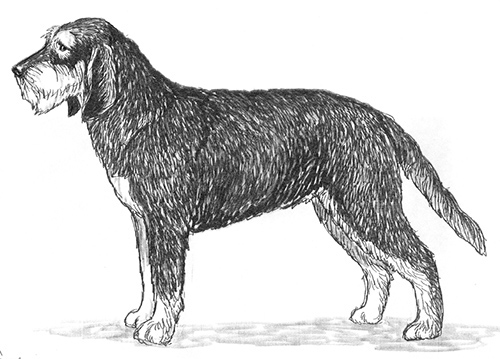Griffon Nivernais
Scenthound Group
The goals and purposes of this breed standard include: to furnish guidelines for breeders who wish to maintain the quality of their breed and to improve it; to advance this breed to a state of similarity throughout the world; and to act as a guide for judges.
Breeders and judges have the responsibility to avoid any conditions or exaggerations that are detrimental to the health, welfare, essence and soundness of this breed, and must take the responsibility to see that these are not perpetuated.
Any departure from the following should be considered a fault, and the seriousness with which the fault should be regarded should be in exact proportion to its degree and its effect upon the health and welfare of the dog and on the dog’s ability to perform its traditional work.
History
Rough-coated hounds, used by farmers and shepherds to control wolves and wild boars, have been bred in the highlands of Central France for many centuries. After the French Revolution, a renewed interest in this type of dog precipitated the development of the Griffon Nivernais, originally known as the Griffon-Vendeen-Nivernais. They are known as wild boar hunters without compare.
The Griffon Nivernais was recognized by the United Kennel Club on January 1, 1995.
General Appearance
The Griffon Nivernais is very typey in a rustic sense; shaggy and unkempt looking due to its hard, tousled coat. It is robust and dry muscled, built for endurance instead of speed. It has a sorrowful expression, but is not timorous.
Characteristics
A very good hunter, the breed is courageous but not reckless, and is well suited to hunt wild boar in small packs. Though easily taught to hunt, the Griffon Nivernais can be stubborn and independent and should be taught to obey at an early age.
Head
The moderately long head is clean and light, but not small.
SKULL
The skull is almost flat. The stop is slight, but is accentuated by the eyebrows.
Faults: Rounded skull. Short skull.
MUZZLE
The muzzle is the same length as the skull. It tapers slightly in width from the eyes to the nose, but is never pointed. The lips just cover the lower jaw.
TEETH
A full complement of strong, white teeth meet in a scissors or level bite.
Disqualifications: Overshot or undershot bite.
NOSE
The prominent nose is black in color.
Faults: Brown nose. Pink nose.
EYES
The eyes are very expressive, with a lively, penetrating gaze. A dark eye is preferred, but a light eye is acceptable. The eyelids are tight and well pigmented.
Faults: Too light eye. Wall eye.
EARS
The ears are supple and fine, attached at the level of the eye, and hanging with a slight inward turn at the end. They are long enough to reach the nose.
Neck
The neck is rather light and dry.
Forequarters
The shoulders are slightly sloping, and the upper arms incline to set the forelegs well under the body.
FORELEGS The forelegs appear very strong because of the hair covering. In reality they are clean and dry rather than thick. The elbows are close to the body, and the pasterns are short and slightly sloping.
Fault: Dewclaws.
Body
In proportion, the body is slightly longer than it is tall. The deep chest extends well down, nearly to the level of the elbows. The brisket, from the prosternum to the end of the breastbone, is moderate, not too wide nor too prominent. The rib cage is deep and carried well back. The first ribs are a little flat; the rear ribs are more rounded. The topline is level from the withers to the loin, which is very slightly arched. The croup is bony and a little slanting. There is a moderate tuck-up, but it is not exaggerated.
Hindquarters
The slope of the pelvis sets the hindquarters slightly under the dog.
HIND LEGS
The thighs are clean and rather flat. The low-set hocks are well angulated.
Fault: Dewclaws.
Feet
Oval in shape, and rather long, like a hare foot. The toes are solid and close together, and the pads and nails are well pigmented.
Tail
The tail is set fairly high, and is not too long. It is carried saber fashion and may be bent somewhat forward over the back.
Coat & Skin
Long, shaggy, bushy and rough, never woolly or curly.
The eyebrows are well marked with hair. The muzzle has a slight moustache. The ears are hairy.
The skin is supple, close fitting and rather thick. There are black spots on the body and the lips are well pigmented.
Faults: Lack of skin pigmentation such as on the nose, lips, eyerims or scrotum.
Color
Preferred colors include wolf gray, blue gray, and wild boar gray (gray grizzle), with tan on the heads and legs, and fawn, with white and black hairs mixed in, giving a dark look. The coat is most often marked with tan points, which are prominent in young dogs and diminish with maturity.
Faults: Black, wheaten, or orange coat. Tri-colored, with the colors too well defined. White feet.
Disqualification: Albinism.
Height
The preferred height range for males is from 21½ to 24½ inches, and for females, from 20½ to 23½ inches. A ¾-inch leeway on either end is permitted for hounds of quality.
Gait
Movement is supple and easy.
Disqualifications
(A dog with a Disqualification must not be considered for placement in a conformation event, and must be reported to UKC.)
Unilateral or bilateral cryptorchid.
Viciousness or extreme shyness.
Albinism.
Overshot or undershot bite.

Looking for a Dog?
Find a dog that will fit your family.
Note: The breeders on this list are not endorsed by UKC.
Revised January 1, 2009
©Copyright 1995, United Kennel Club
